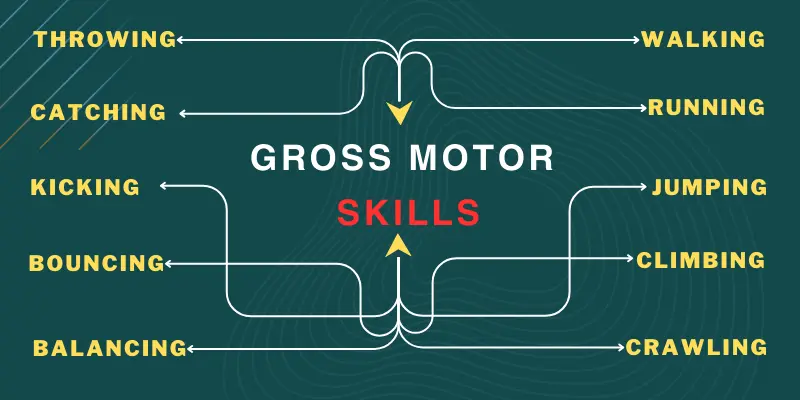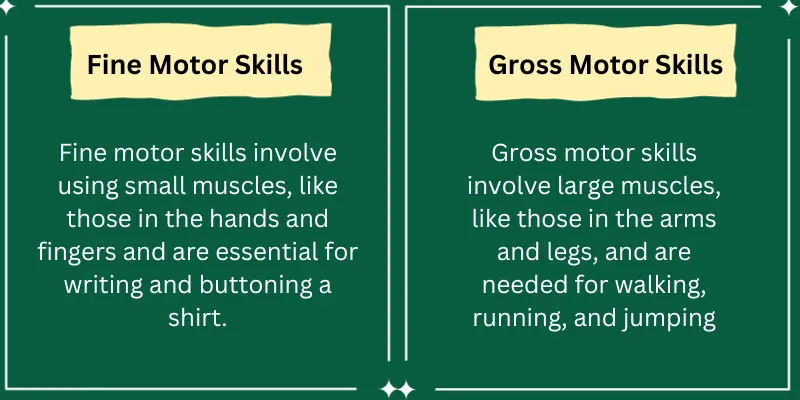From Crawling to Climbing – A Journey Through Gross Motor Skill Development
Updated: 21 Oct, 23
91
Is your child learning new things, like walking, jumping, or running? This is the central developing part of your child’s age.
These achievements are known as gross motor skills, a pivotal aspect of your child’s development.
In this article, we will discuss the importance and types of gross motor skills.
So, let’s start.
What are gross motor skills?
Kinetic abilities are the large movements we use to interact with the world. They involve the large muscles in our arms, legs, and torso. Large motor skills are essential for everyday activities such as walking, running, jumping, climbing, and playing sports.

The importance of gross motor skills
Gross motor skills are important for children’s physical development as well as their cognitive and social development. Strong motor skills help children to explore their environment, learn new skills, and participate in activities with their peers.
Gross motor skills are also important for children’s self-esteem and confidence. When children can master new Fundamental movement skills, they feel good about themselves and their abilities, which can lead to increased motivation to learn and try new things.
Difference Between Gross And Fine Motor Skills
Gross motor skills: These involve large muscles, like those in the arms and legs, and are needed for walking, running, and jumping.
Fine motor skills: Fine motor skills involve using small muscles, like those in the hands and fingers, and are essential for writing and buttoning a shirt.

There are two main types of gross motor skills:
- Locomotion skills: These are skills that involve moving from one place to another, such as walking, running, jumping, hopping, and climbing.
- Manipulative skills: These are skills that involve using the hands and feet to manipulate objects, such as throwing, catching, kicking, and batting.
Fundamental movement skills are important for children of all ages. They allow children to explore their environment, participate in activities with their peers, and develop a sense of self-efficacy.
How gross motor skills develop
Motor coordination develops in a predictable sequence, from simple movements such as rolling over and sitting up to more complex activities such as running and jumping.
Children typically reach gross motor skill milestones at different ages, but some general guidelines exist.
For example, most babies roll over by 6 months, sit up without support by 8 months, and walk by 12 months. By the time children are 3 years old, they should be able to easily run, jump, and climb.
Activities to promote gross motor skills
There are many activities that parents and caregivers can do to help children develop strong physical coordination
Some examples include:
- Tummy time: Tummy time helps strengthen the neck and shoulder muscles, essential for gross motor development. Place babies on their stomachs for several minutes each day, starting from a very young age.
- Playgrounds: Playgrounds are a great place for children to practice various Motor coordination, such as climbing, swinging, and sliding.
- Outdoor activities: Walking, running, and biking are also great for gross motor development.
- Sports: Sports such as soccer, basketball, and baseball are fun for children to develop Physical coordination and learn teamwork.
Tips for parents and caregivers
Here are some tips for parents and caregivers to help children develop strong gross motor skills:
- Provide plenty of opportunities for children to move and explore.
- Make sure children have access to safe and age-appropriate play equipment.
- Encourage children to participate in a variety of physical activities.
- Be patient and supportive. It takes time and practice for children to develop new Motor coordination.
Talk to their paediatrician if you have concerns about your child’s gross motor development. They can assess your child’s skills and guide you on how to help them develop.
Conclusion
In short, gross motor skills are significant movements your body makes, like walking and running. They are crucial for kids to explore and play. These skills also boost their confidence when they learn new things.
There are two types of these skills: moving skills (like walking and jumping) and using hands or feet to control things (like throwing or catching).
Kids develop these skills as they grow, but there are general guidelines for when they should learn them. For example, most babies roll over at around 6 months, sit up by 8 months, and start walking around their first birthday.
Parents and caregivers can help kids learn these skills through fun activities like playing at the park, going for walks or bike rides, and joining sports teams. It’s essential to give kids a chance to move and explore.
Talk to your child’s doctor if you have concerns about their development. The doctor can offer advice on how to help them improve these skills.
FAQs
What are the examples of gross motor skills?
Here are some examples of gross motor skills:
- Locomotion skills: walking, running, jumping, hopping, climbing, crawling, rolling, galloping, skipping, sliding
- Manipulative skills: throwing, catching, kicking, batting, bouncing, juggling, balancing, turning, twisting
why gross motor skills are important?
Gross motor skills are important because they enable us to perform essential daily activities. Including:
- Physical development: Gross motor skills help children develop strong muscles, bones, and joints. They also help children improve their balance, coordination, and flexibility.
- Cognitive development: Gross motor skills help children learn about their bodies and the world around them. They also help children develop problem-solving skills and spatial awareness.
Social and emotional development: Gross motor skills allow children to participate in activities with their peers and to develop a sense of self-efficacy. They also help reduce stress and improve mood.
list of gross motor skills.
| List 1 |
|---|
|
| List 2 |
|---|
|
when do gross motor skills develop?
Gross motor skills typically develop in a predictable sequence as children grow. Here are some general guidelines for when these skills tend to develop:
- Most babies can roll over at around 6 months.
- Babies typically learn to sit up without support by 8 months.
- Walking usually begins at approximately 12 months.
Children gradually acquire more advanced gross motor skills, like running, jumping, and climbing. Remember that individual development may vary.
Some children may reach these milestones at different ages.
Please Write Your Comments